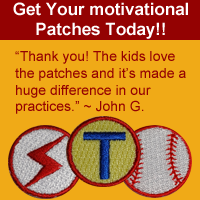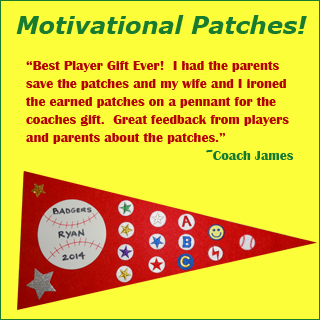Outfield - Throwing
As I relate in the Playing Catch section, the first time I remember being taught to throw by someone other than my Dad or brother, was in college. The reason I believe it's important to mention here is for an outfielder, the ability to make a long accurate throw is an important skill. More importantly it's a skill that can be improved and learned. After learning how to throw properly and working on that skill, my ability to throw the ball well became one of the skills that I was most proud of. I used to circle the ball (covered in the Outfield - Ground Ball section) on a base hit and I would act as if I wasn't in a hurry, just hoping that the runner would see that and try to take an extra base or take a big turn. Either way, I was trying to set up a situation where I could gun him out. For me that was confidence in my ability. In the outfield you want to get the ball in quickly to prevent a runner from advancing, but in my mind I was always hoping they would try for that extra base. I enjoyed that feeling of confidence. If your a player, know you can always improve your ability to throw the ball well. Hopefully you will give it the attention necessary to develop it into one of your most prized baseball skills.
More information on throwing technique can be found in the Playing Catch section of this site.
Hitting The Cutoff
Many coaches continually yell out to the outfield during the game, "Hit the cutoff man", "Make sure you hit the cutoff", "Why didn't you hit the cutoff?". But, unless you practice plays which require a decision to be made during practice, your outfielders may not really understand why it's important. During practice don't always have the ball go through to the base. Have your players use "Cut" followed by a different base.
When working on hitting the cutoff man in practice. Don't overlook the positioning of the cutoff. The following is a common example from an outfielders point of view. The outfielder in question has a strong arm. A runner is on first and there is a hit. The runner is going to attempt to make it to third base. The outfielder knows he has a great chance of throwing the runner out at third. The problem is the cutoff man has come out way too far. If he hits the cutoff man they probably won't get the runner at third. If he throws the ball to third, he has failed to hit the cutoff man. Either way he'll probably feel like he did the wrong thing. You may give him positive feedback if he hits the cutoff man on that play, but it's not that often that he gets a chance to throw a runner out and believe me your positive feedback won't take away from the fact that he had an opportunity taken away from him.
Infielders need to be taught to be aware of the arm strength and position on the field of the outfielder making the throw. You want your cutoff man, if necessary, to make a short accurate throw. They shouldn't be cutting the distance in half. They should be trying to maximize the arm of the outfielders. Remember this is two sided. If the cutoff person errors on the side of being too far away from the outfielder, the outfielder must recognize his limitations and throw the ball on one hop to the cutoff person.
Player Tip
There is no quicker way to a negative reaction from a coach then to miss the cutoff man.. Always aim low. If the cutoff man is too far away and you think you need to throw it real high to get it there, aim low instead. A nice long one hop bounce will be easy for him to field and will get there quicker than tying to get it there in the air. It will also save you from a dugout discussion about the importance of hitting the cutoff man.
Shuffle
There are many times when you can't get yourself set up to use a crow hop. So how do you gain momentum to make a long throw? The answer is a shuffle of the feet. It's very similar to the type of shuffle you would use when leading off a base. The difference is that on the last shuffle before throwing the ball you will cross your back leg behind your front leg, plant it, push off and throw.
Below is a shuffle being performed from right to left. The fielder has just backhanded a ground ball and has planted his right leg. He's too deep in the outfield to be able to just step and throw. So to gain momentum towards his target, he is going to shuffle towards the target and then throw.
Steps:
- Ball is fielded and player has slowed down and planted his back leg.
- Step forward with front leg toward the target. Keep shoulder closed.
- Plant front leg and start to bring back leg forward. You're gaining momentum.
- Cross back leg behind front leg. This is similar to the hop in the crow hop, but since you're body is already lined up towards the target, it's much easier to cross your leg behind. This also keeps your front shoulder and hip closed, ready to throw.
- Plant your back leg, stride with your front leg, and throw the ball.

Use Anytime
The example above was on a ball that was backhanded, but the shuffle can be used on any play. Some players prefer this method to the crow hop and use it even when they could have used a crow hop. Personally, I find I can get more on the ball using the crow hop, but the shuffle throw is still a necessary skill that you will use on a regular basis.
Arm Strength
There's no substitute for throwing a baseball. Often players ask what they can do to improve their arm strength. While there are some great resources for weight lifting and other conditioning exercises that can help, I believe long toss is the single most beneficial thing you can do to gain arm strength.
Player Tip
Some keys to throwing accurately from the outfield include:
- Always use a full arm motion, don't use a short throwing motion like an infielder or catcher.
- Always grip the ball across the seems. Improper grip on the ball can cause it to tail and or dip when you throw.
- Throw overhand not three-quarter or from the side. Throwing the ball overhand with the proper grip will allow you to throw the ball on a line.
Most Recent Blog Posts
Working With Players on Focusing on the Correct Part of the Baseball when Hitting (October 15 2016)
Getting More Accurate Throws From Your Team (April 5 2016)
Youth Coaching Advice
If your players can throw and catch, don't assume that means they know how to throw and catch. In the outfield, incorrect grip and throwing mechanics will lead to balls being thrown all over the place. Throwing should be worked on every year.
Just wanted to say Thank you for the great website. Great information for this new coach. It sounds like baseball gave a lot to your life, so thanks for giving back to baseball.
- Ray K.







